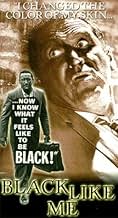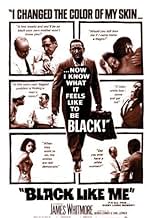Based on the true story of a white reporter who, at the height of the civil-rights movement, temporarily darkened his skin to experience the realities of a Black man's life in the segregated... Read allBased on the true story of a white reporter who, at the height of the civil-rights movement, temporarily darkened his skin to experience the realities of a Black man's life in the segregated South.Based on the true story of a white reporter who, at the height of the civil-rights movement, temporarily darkened his skin to experience the realities of a Black man's life in the segregated South.
- Awards
- 1 win total
Lenka Peterson
- Lucy Horton
- (as Lenka Petersen)
P. Jay Sidney
- Frank Newcomb
- (as P.J. Sidney)
Featured reviews
John Howard Griffin was a white reporter who darken his skin to experience life as a black man in the deep South. This is based on his book. John Finley Horton (James Whitmore) from Texas wants to write a series of articles on integration for Eli Carr (Clifton James) but he's afraid of the repercussions. He gets treatments of pills and tanning lamps to darken his skin. Along the way, he reveals the truth to shoeshine Burt Wilson (Richard Ward) and gets his help to pass.
"I changed the color of my skin... now I know what it feels like to be BLACK!" They couldn't get away with that tagline today. No matter how well the disguise, the color doesn't come off of a black man at the end of the day. Its heart is in the right place, but James Whitmore looks like a darkened white man. The eyes are one problem and he needs a good pair of sunglasses. The other problem is that it isn't always a compelling movie. There are scenes of eye opening racism. There are also weird little scenes about race relations. It's put together like a series of disconnected vignettes. As a movie, it doesn't really flow and the acting sometimes fall into melodrama territories. It's still interesting to watch.
"I changed the color of my skin... now I know what it feels like to be BLACK!" They couldn't get away with that tagline today. No matter how well the disguise, the color doesn't come off of a black man at the end of the day. Its heart is in the right place, but James Whitmore looks like a darkened white man. The eyes are one problem and he needs a good pair of sunglasses. The other problem is that it isn't always a compelling movie. There are scenes of eye opening racism. There are also weird little scenes about race relations. It's put together like a series of disconnected vignettes. As a movie, it doesn't really flow and the acting sometimes fall into melodrama territories. It's still interesting to watch.
This is a good movie but the book is better. In the book the emotions unfold over a longer period of time which is more realistic. The premise of both (without spoilers): white journalist darkens skin in order to appear black and details his experiences as a black man in the south in a book. Therein lies the problem. Griffin's life as a white man is not erased by the darkening of his skin. For example, in both the book and the movie, Griffin looks for normalcy in activities that blacks during that time period were aware would result in hostility. Going into white neighborhoods attempting to get change in stores. Offensive conversations in cars with whites while hitch hiking, etc. To be clear, blacks were definitely angered by any indignities caused by these experiences. However many of the blacks during that time period never had the privileges that Griffin had had all of his life. My point is that Griffin's anger reaches a crescendo at a quick pace because of a life of white privilege suddenly hindered by dark skin. Blacks cared about daily indignities but always with a concern over the larger political and social institutions and structures that created them. The book and the movie are accurate in many ways, but they represent merely a snapshot of a much larger scheme.
This is the sleepy South as it really was. The pace is deliberate but necessarily so. The direction and acting is gritty and real.
The anger was real. The prejudice was real. The hate was real. The fear was real. The pain was real. It really happened this way.
This movie shows us all that. We walk in the shoes of a white man who looks like a black man...but we will never know. We can only imagine like James Whitmore's character, John Horton. We can only imagine what a man or woman had to endure in the unilluminated history of the United States.
Seeing this, we know, though we have come quite some distance, that we have still a long way to go before the reality is but a memory.
I salute all of those involved in this film and Mr. John Howard Griffin who endured it all and let us know the cruelty of man and helped us open our eyes.
The anger was real. The prejudice was real. The hate was real. The fear was real. The pain was real. It really happened this way.
This movie shows us all that. We walk in the shoes of a white man who looks like a black man...but we will never know. We can only imagine like James Whitmore's character, John Horton. We can only imagine what a man or woman had to endure in the unilluminated history of the United States.
Seeing this, we know, though we have come quite some distance, that we have still a long way to go before the reality is but a memory.
I salute all of those involved in this film and Mr. John Howard Griffin who endured it all and let us know the cruelty of man and helped us open our eyes.
Unfortunately, the quality of this movie was hindered by the poor production values of the period, as well as a low budget. This is the true story of John Howard Griffin (in the movie referred to as John Finley Horton, a Caucasian man who cared enough about the issues of racism that he put himself and his family in danger by posing as an African American man who traveled through the then racist Deep South of the United States in the late 1950's. The movie does not entirely succeed in capturing the terror, the weariness, the lack of dignity, and the outright hatred experienced by the lead character simply because of the color of his skin. However, seeing this movie should stimulate one's curiosity enough to read the book, one of the best and most disturbing I have ever read and whose message is still relevant today And for those of you poor souls who believe that this movie is little more than an example of "reverse racism," I suggest you consult a dictionary because there is no such term.
The person who claimed this is a movie about "reverse racism" must be so young that he can't remember those times. I grew up in the 50's and 60's in the south. The movie portrays the prevailing attitude of whites toward blacks in an accurate manner. I can remember the separate waiting rooms, water fountains, "white only," etc. Thankfully, I grew up in a home where racial prejudice was not tolerated, and I'm sure there were a lot of homes like this.
In the book, Griffin passes through the same area as a black and then a white. The difference in his treatment was appalling. What the movie shows is that racial prejudice makes no sense. All people are simply people and deserve to be treated with respect.
In the book, Griffin passes through the same area as a black and then a white. The difference in his treatment was appalling. What the movie shows is that racial prejudice makes no sense. All people are simply people and deserve to be treated with respect.
Did you know
- TriviaGriffin actually went through the pigment darkening process twice. The first time was for his original article in Sepia Magazine. The second time was much later for the book, when he returned to some of the same locales to be photographed in character.
- GoofsWhen Horton, after meeting the PhD student, opens his wallet to pay in the diner, something falls out of it near the counter. No one notices or refers to it.
- ConnectionsFeatured in Classified X (2007)
- How long is Black Like Me?Powered by Alexa
Details
Box office
- Budget
- $273,000 (estimated)
- Runtime
- 1h 45m(105 min)
- Color
- Sound mix
Contribute to this page
Suggest an edit or add missing content

































